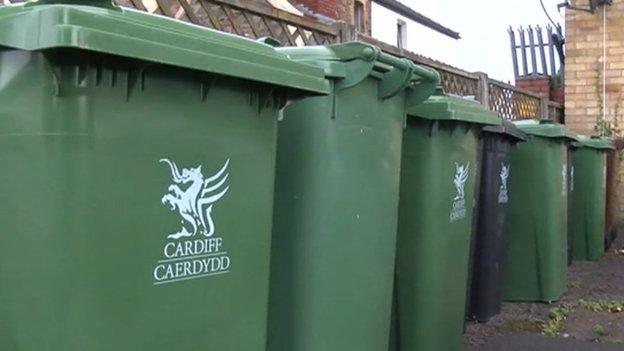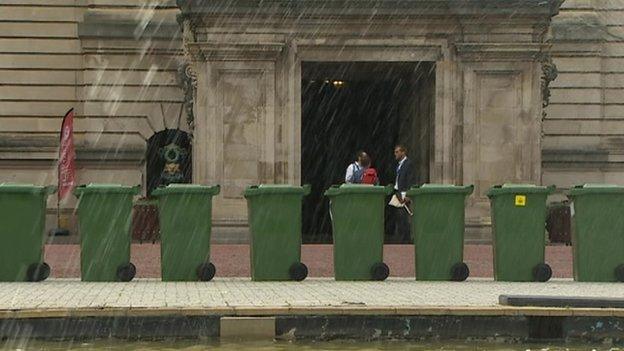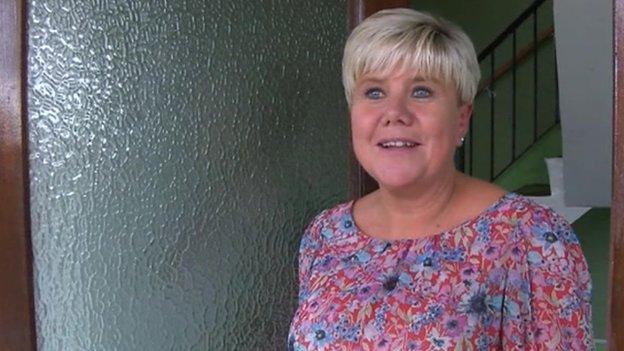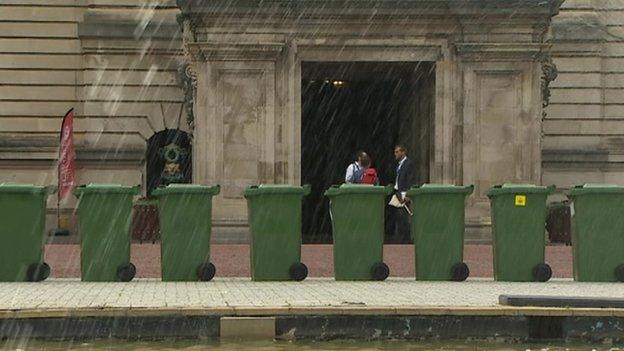Challenging recycling targets lead to bin collection changes
- Published

Protestors mocked Cardiff council for delivering garden waste bins to flats with no gardens
Where there's muck there's brass goes the saying - as Welsh councils have been finding out.
They face tough targets to recycle household waste - and if they don't hit those targets, they will be hit hard by fines.
Over the last couple of years, this has meant changes to what rubbish is collected, when it is collected and how it is collected.
Some decisions have proved unpopular, with this fact illustrated by the reaction to Cardiff council's new system that was launched on Monday.
Cardiff was the worst-performing authority in Wales when figures for December 2014 were released, recycling 48% of its waste. The Welsh government has set each local authority a target of hitting 58% by March 2016.
In an effort to meet this target, Cardiff council has spent £1.6 million on waste collection changes that include reducing the size of its black refuse bins and sending out green waste wheelie bins.

Cardiff residents unhappy with the new wheelie bins left them outside City Hall
Some residents, who don't have gardens, called the new green bins a "waste of money" and protested by taking them to city hall last Thursday, saying they "ruined" the look of the area.
Alison Hambury in Llandaff North, Cardiff, said her block of eight flats was given nine green bins and eight black bins.
"I'm all for recycling, I just don't really see the point of all the bins and I don't see how we're saving money," she said.

Alison Hambury from Cardiff said it was "ridiculous" a block of flats was given garden bins
But Julie Richardson from Canton said she participates in surveys for the council, and had said yes to the wheelie bins.
"We used to have black bin bags and now the seagulls can't attack my bins any more. It makes the street cleaner."
Bob Derbyshire, Cardiff council's Cabinet Member for the Environment, said claims the public was not informed about the move "frankly beggars belief".
He said the council conducted a survey, consultations, and a publicity campaign.
Other councils around Wales have experienced problems. Rhondda Cynon Taf council, for example, estimated that 20% of recycling bags left by residents are "contaminated" with the wrong type of waste. It has told its workers not to collect these.
In Merthyr Tydfil, some residents complained new bins for non-recyclable were too small, while in Blaenau Gwent, there have been concerns that some residents may struggle getting new recycling trolleys up steps to their properties.
With questions raised about decisions made to avoid hefty fines, here is a look at what councils are doing around Wales.

Anglesey
On Anglesey, there is an alternate weekly collection of green waste and refuse alongside a weekly collection of dry recycling and food waste.
This method started as a trial in 2005 and was rolled out to the whole island by 2007. While a spokesman said there were initial "teething problems", recycling rates have improved and there have been no issues with things like fly-tipping. Anglesey was recycling 55% of its waste in December 2014, 3% short of the target required by March 2016.
Blaenau Gwent
Blaenau Gwent is the joint third-worst performing authority in Wales (December 2014 figures showed it recycled 51% of its waste).
To address this, it has recently started a process of sending out new Troliblocs (a stack of three recycling boxes on a wheeled trolley) to its residents. These separate paper, metals, plastics and glass and cardboard, and all houses should have these by October.
The cost of the new system will be between £3.8m and £4.3m, with some of this cost met by a Welsh government grant.
When the new system replaces the collection of bags in the Autumn, the council hopes that it will generate income as well as improving recycling rates. Because the materials are already sorted, officers estimate between £150,000 and £250,000 could be made annually. Black bags will also be collected every three weeks.
While some residents were concerned about storing the Troliblocs or moving them down steps outside their properties, the local authority said it would supply alternative systems if people were struggling to manage them.
Bridgend
Bridgend has one of the longest-established systems in Wales. It gave a contract in 2010, that runs until 2017, for weekly collections of paper, glass and cardboard in black boxes, plastics and tins in hessian sacks and food waste in caddies. Black bags are collected fortnightly.
The council is on target to achieve the Welsh government target of 58% by 2015-16, with rates fluctuating between 56% and 58% over the months from December 2013 to December 2014.
Caerphilly
Caerphilly council spent £1.45 million on its recycling scheme in 2009 - this comprised of £1m for bins, £350,000 for food caddies and £100,000 towards a doorstep education campaign.
It now runs a weekly co-mingled recycling collection using the bins, a weekly food and green waste collection and a fortnightly rubbish collection.
A spokeswoman said the outlay has made a "significant" difference. Caerphilly council currently recycles 56% of its waste.
Cardiff
Cardiff council was the worst performing local authority in Wales, achieving 48% in December 2014. But it expects this figure to rise to 53% when a new league table is published in August.
The authority has spent about £1.6m on new wheelie bins and launched a new collection initiative on Monday.
Carmarthenshire
Carmarthenshire council officers believe they are on course to hit the 60% recycling mark for 2014-15.
Its system was introduced in 2008 and is reviewed regularly, with minor changes made.
Food waste is collected weekly, while blue bags for mixed recyclables and black bags for non-recyclables are collected on alternate weeks. In addition, the council has five household waste recycling centres and 170 bring-it-yourself sites.
Ceredigion
Between December 2013 and December 2014, Ceredigion's recycling rate jumped higher than that of any other council in Wales - from 55% to 62%.
The system it uses sees weekly collections of different recyclable materials in a clear plastic bag and food waste, which is collected separately by the same vehicle. Residual waste is collected fortnightly.
This scheme has been in operation since 2010, and while it puts the local authority on target for 2015-16, a review is currently taking place to see if money could be saved by using an alternative collection method.
There are seven options being looked at by council officers, which include keeping the system as it is, fortnightly recycling collections and separating materials further.
Conwy
Conwy collects dry recyclables (cans, paper, plastic, card and batteries) and food waste weekly. Green garden waste, textiles and small electrical items and non-recyclable waste are collected fortnightly.
The whole local authority has been covered since November 2013 and the council is confident it will meet the required rate of 58% by March 2016.
Denbighshire
Denbighshire has had the same system in place since April 2009 and achieved a 70% recycling rate between April and June 2014.
This sees mixed dry recyclables, black bins and green bins collected fortnightly and food waste collected weekly.
Changes to garden waste collections in April, saw them switched from a free opt-in service to a chargeable collection. Projections for 2015-16 suggest that this will achieve its aim of reducing council spending by £400,000 per year.
Like most other councils, Denbighshire does not fine residents for mistakes, but leaves bins unemptied if they contain the wrong waste.
While the council has already hit the 2024-25 target (70%), officers are concerned that changes to Welsh government requirements for collections may affect its performance going forward.
Flintshire
In Flintshire, residents separate recycled materials, which are collected and transported in different vehicles.
This method has been in operation since 2012 and achieved a 56% rate in December 2014.
Gwynedd
It is predicted that changes in collection methods for the 15,000 households in Dwyfor will lead to savings of £100,000. When these are rolled out completely to the 19,000 homes in Meirionnydd and 26,000 in Arfon, Gwynedd council predicts it can make annual savings of £414,000.
Currently, the council collects food waste brown bins and blue boxes for recyclables weekly, and brown wheelie bins for garden waste fortnightly.
The changes in Dwyfor, introduced in October 2014, and recently to Meirionnydd, will see non-recycled waste collected every three weeks. A nappy collection service has also been introduced, as well as a three-tiered cart to make recycling easier.
A spokesman said: "We are confident that the new arrangement will help to avoid the substantial financial penalties that the council (and by extension Gwynedd residents) would face if it was to fail to hit national recycling and landfill targets."
Merthyr Tydfil
A new system was introduced in January, with officers saying it is too early to predict the impact it will have on recycling rates (Merthyr Tydfil was the joint third-worst recycler in Wales in December 2014, with a figure of 51%). However, it is hoped the new system will bring savings of £1,038,000 annually.
The Welsh government gave the council £2m to improve rates last August. The first phase was rolled out in January, when 240 litre wheeled bins were replaced by new 140 litre bins. At the time, some residents took to Facebook to complain these were not big enough to fit all their rubbish in.
From June, residents were also asked to separate their recyclables rather than put them in the same container, while garden waste collections changed from weekly to fortnightly and seasonal from April to November.
Monmouthshire
Monmouthshire council has been running a scheme for over five years where it collects residual waste fortnightly and recyclable material weekly. This achieved a rate of 65% by December 2014.
There has been a recent change to collection days, that allow vehicles to cover the whole area quicker. It is hoped this will save the local authority around £250,000 a year.
Neath Port Talbot
The local authority is on track to achieve 58% recycling by March 2016, after posting a figure of 57% in December 2014.
It has introduced a number of initiatives aimed at improving rates, including Recycle Plus, which was launched in July 2014. This saw a 180 litre bag sent out to residents, which allows them to recycle a wider range if items, such as plastic, card, cartons and aerosols.
Newport
In Newport, blue boxes for papers, mobile phones, printer cartridges and textiles, green boxes for glass, cans and aerosols and food caddies are collected weekly. Garden waste and cardboard collections take place fortnightly.
In December 2014, the local authority recycled 52% of its waste.
Pembrokeshire
Pembrokeshire has a twin stream system, where mixed dry recyclables are collected in sacks while there are separate containers for collecting food and glass. It achieved a rate of 65% in December 2015, meaning it has already hit its 2015-16 target.
Powys
Powys currently collects recycling weekly in a kerbside multi-box system that comprises of an aqua box for glass, blue box for paper and card, a red box for plastic and cans and a kitchen caddy for food waste.
This has helped Powys achieve a rate of 52% and there are no plans to change it.
However, the council will be holding a consultation in August as it considers a plan to collect rubbish every three weeks. As well as encouraging residents to recycle more as it seeks to achieve an "extremely challenging" rate by 2015-16, it hopes this would also save the council £500,000 a year.
Rhondda Cynon Taf
In December 2014, it recycled 50% of its waste.
The council estimated that 20% of bags left out for recycling are contaminated with wrong types of waste and now leaves stickers on these without collecting them.
Swansea
Swansea has trialled a number of different methods in an effort to increase its recycling rate.
In April, 3,200 pink recycling bags were sent out to residents in St Thomas, Bonymaen, Pentrechwyth, Pontlliw and Pontarddulais as part of a trial.
These were twice the size as the old bags used, and designed to be heavier so they did not blow away.
In December 2014, Swansea recycled 57% of its waste.
Torfaen
Currently, Torfaen recycles 52% of its waste, but hopes changes to collections will help it achieve the target of 58%.
Recyclables and food waste are collected weekly and cardboard and green waste fortnightly. From September, black wheelie bins will be changed from a 240 litre size to 140 litres. "Many residents continue to use their wheelie bins to dispose of waste that could be recycled - by reducing the amount of general waste we collect we expect to see an increase in recycling rates," a spokesman said.
This change is not expected to free up any extra cash, with any savings countered by the cost of the new bins.
Vale Of Glamorgan
In April 2015 changes were made, with the most significant, a new charge for the collection of bulky items of £15 for up to three pieces. It is hoped this will save the authority £270,000 a year.
Despite concerns that this may lead to an increase in fly-tipping, there was a reduction in the Vale of Glamorgan between April and June 2015.
Since 2011, different recyclables and food waste have been collected weekly, with residual waste and garden waste fortnightly.
Vale of Glamorgan hit 56% recycling in December 2014, but officers say it is too early to say whether or not it will achieve 58% by 2015-16.
Wrexham
Residents in 350 properties recently took part in a pilot, trialling different collection ideas. What the council found was that a "one size doesn't fit all" and said it would take into account the type of home people live in before introducing new methods.
The trial took place partly because the collection fleet is "becoming old and inefficient" and will need replacing. Wrexham achieved a 57% recycling rate in December 2014.
Currently, black bags and food waste are collected fortnightly, while residents also have a blue bag for card and newspaper and green box for plastic bottles.

Tim Peppin, the Welsh Local Government Association's (WLGA's) director of regeneration and sustainable development, said that if local authorities do not meet targets, Welsh ministers have the power to impose fines.
These would amount to £200 for every tonne by which an authority fails to meet its target. For example, if an authority needs to recycle 4,000 tonnes more to hit the percentage target, it could potentially be hit with a £800,000 fine.
The Welsh government has set its authorities targets of recycling 58% by 2015-16 and 70% by 2024-25.
While in theory, large fines could be applied, in practice, Mr Peppin said this may not happen.
The target for 2012-13 was 52% and no authority was fined then for missing the target. Mr Peppin said that the possibility of fines would increase if an authority was seen to be doing nothing to improve recycling rates.
'Challenging geography'
Looking at the landscape in Wales, he said Cardiff faced particular problems. With a large student population, multiple occupancy buildings such as halls of residence and a relatively high number of flats, he said it would be difficult for it to develop a standard approach for collecting across the city. Different methods would need to be employed in the different types of buildings.
Major venues and attractions such as the Millennium Stadium and Motorpoint arena also create problems in that they bring large amounts of people into the city who create waste.
He added that there are collection issues in authorities like Rhondda Cynon Taf and Blaenau Gwent, saying: "The geography of the valleys creates challenges associated with inaccessible back lanes, difficulties taking waste receptacles through terraced houses, lack of space on pavements at the front of some properties and delays to traffic caused by collection vehicles."
However, a Wales-wide rate of 56% puts the country well ahead of England, Scotland and Northern Ireland, who are all around the 45% mark.
The European Union target is currently 50%, although discussions have taken place over increasing the level to 70%.
'More challenging'
Despite Wales' good target-led results in comparison to the rest of the UK, Rhondda Cynon Taf leader Andrew Morgan, who is the WLGA spokesman on waste, said the aim of "no waste by the 2050s" is unrealistic.
He said: "The concern is the next target (after 2015/16) is 70%, that's why some local authorities are going to three weekly collections. But each local authority must determine for itself what's best in its own area.
"The targets do get more challenging."
Environmentalist and author Tony Juniper also called for producers to do their bit. He said there should be national standards and packaging such as films, cans and plastics should be designed to fit in with recycling schemes.
- Published23 July 2015
